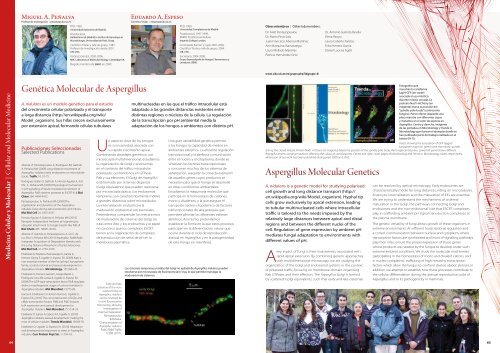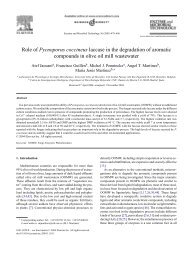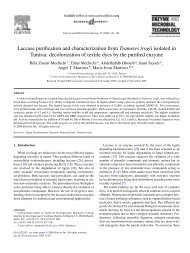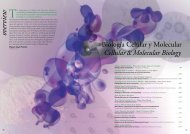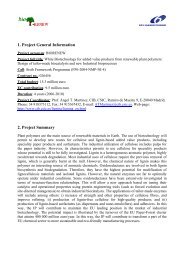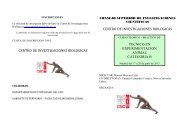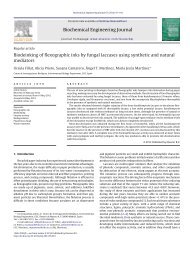03 Medicina Celular y Molecular.pdf 5474KB May - Centro de ...
03 Medicina Celular y Molecular.pdf 5474KB May - Centro de ...
03 Medicina Celular y Molecular.pdf 5474KB May - Centro de ...
You also want an ePaper? Increase the reach of your titles
YUMPU automatically turns print PDFs into web optimized ePapers that Google loves.
<strong>Medicina</strong> <strong>Celular</strong> y <strong>Molecular</strong> | Cellular and <strong>Molecular</strong> Medicine<br />
64<br />
miguel a. Peñalva<br />
Profesor <strong>de</strong> Investigación | penalva@cib.csic.es<br />
PhD, 1982.<br />
Universidad Autónoma <strong>de</strong> Madrid.<br />
Postdoctoral,<br />
Antibióticos SA (Madrid) e Institut <strong>de</strong> Genetique et<br />
Microbiologie, Universidad <strong>de</strong> París, Orsay.<br />
Científico Titular y Jefe <strong>de</strong> grupo, 1987,<br />
Profesor <strong>de</strong> Investigación <strong>de</strong>s<strong>de</strong> 2001.<br />
CIB, CSIC.<br />
Visiting Scientist, 2005-2006.<br />
MRC Laboratory of <strong>Molecular</strong> Biology, Cambridge UK.<br />
Elegido miembro <strong>de</strong> EMBO en 2000.<br />
Genética <strong>Molecular</strong> <strong>de</strong> Aspergillus<br />
A. nidulans es un mo<strong>de</strong>lo genético para el estudio<br />
<strong>de</strong>l crecimiento celular polarizado y el transporte<br />
a larga distancia (http://en.wikipedia.org/wiki/<br />
Mo<strong>de</strong>l_organism). Sus hifas crecen exclusivamente<br />
por extensión apical, formando células tubulares<br />
Publicaciones Seleccionadas<br />
Selected Publications<br />
Abenza JF, Pantazopoulou A, Rodríguez JM, Galindo<br />
A, Peñalva MA [2009] Long-distance movement of<br />
Aspergillus nidulans early endosomes on microtubule<br />
tracks. Traffic 10: 57-75.<br />
Rodríguez-Galán O, Galindo A, Hervás-Aguilar A, Arst<br />
HN, Jr., Peñalva MA [2009] Physiological involvement<br />
in pH signalling of Vps24-mediated recruitment of<br />
Aspergillus PalB cysteine protease to ESCRT-III. J Biol<br />
Chem 284: 4404-4412.<br />
Pantazopoulou A, Peñalva MA [2009] The<br />
organization and dynamics of the Aspergillus<br />
nidulans Golgi during apical extension and mitosis.<br />
Mol Biol Cell 20: 4335-4337.<br />
Hervás-Aguilar A, Galindo A, Peñalva MA [2010]<br />
Receptor-in<strong>de</strong>pen<strong>de</strong>nt Ambient pH signaling by<br />
ubiquitin attachment to fungal arrestin-like PalF. J<br />
Biol Chem 285: 18095-18102.<br />
Abenza JF, Galindo A, Pantazopoulou A, Gil C, <strong>de</strong><br />
Los Ríos V, Peñalva MA [2010] Aspergillus RabB/Rab5<br />
Integrates Acquisition of Degradative I<strong>de</strong>ntity with<br />
the Long Distance Movement of Early Endosomes.<br />
Mol Biol Cell. 21:2756-2769.<br />
Etxebeste O, Markina-Iñarrairaegui A, Garzia A,<br />
Herrero-García E, Ugal<strong>de</strong> U, Espeso EA. [2009] KapI, a<br />
non-essential member of the Pse1p/Imp5 karyopherin<br />
family, controls colonial and asexual <strong>de</strong>velopment in<br />
Aspergillus nidulans. Microbiology. 155:3934-45.<br />
Etxebeste O, Herrero-García E, Araújo-Bazán L,<br />
Rodríguez-Urra AB, Garzia A, Ugal<strong>de</strong> U, Espeso EA.<br />
[2009] The bZIP-type transcription factor FlbB regulates<br />
distinct morphogenetic stages of colony formation in<br />
Aspergillus nidulans. Mol Microbiol. 73:775-89.<br />
Garzia A, Etxebeste O, Herrero-García E, Ugal<strong>de</strong> U,<br />
Espeso EA. [2010] The concerted action of bZip and<br />
cMyb transcription factors FlbB and FlbD induces<br />
brlA expression and asexual <strong>de</strong>velopment in<br />
Aspergillus nidulans. Mol Microbiol. 75:1314-24.<br />
Etxebeste O, Garzia A, Espeso EA, Ugal<strong>de</strong> U. [2010]<br />
Aspergillus nidulans asexual <strong>de</strong>velopment: making the<br />
most of cellular modules. Trends Microbiol. 18:569-76.<br />
Etxebeste O, Ugal<strong>de</strong> U, Espeso EA. [2010] Adaptative<br />
and <strong>de</strong>velopmental responses to stress in Aspergillus<br />
nidulans. Curr Protein Pept Sci. 11:704-18.<br />
eduardo a. espeso<br />
Científico Titular | eespeso@cib.csic.es<br />
Un aspecto clave <strong>de</strong> los hongos<br />
es su invasividad, asociada con<br />
su rápido crecimiento apical.<br />
Combinando abordajes genéticos con<br />
microscopía multidimensional, estudiamos<br />
la organización <strong>de</strong> Golgi y endosomas<br />
en el contexto <strong>de</strong>l tráfico intracelular<br />
polarizado, centrándonos en GTPasas<br />
Rab y sus efectores. El Golgi <strong>de</strong> Aspergillus<br />
está formado por cisternas dispersas<br />
(Golgi equivalents) que pue<strong>de</strong>n resolverse<br />
por microscopía óptica. Los endosomas<br />
tempranos son característicamente mótiles<br />
a gran<strong>de</strong>s distancias sobre microtúbulos.<br />
La internalización endocítica y la<br />
maduración endosomal son esenciales.<br />
Preten<strong>de</strong>mos compren<strong>de</strong>r los mecanismos<br />
<strong>de</strong> maduración <strong>de</strong> cisternas <strong>de</strong>l Golgi, las<br />
rutas entre éste y los endosomas y el papel<br />
no canónico que los complejos ESCRT<br />
tienen en la organización <strong>de</strong> complejos<br />
<strong>de</strong> transducción <strong>de</strong> señal <strong>de</strong> pH en la<br />
membrana plasmática.<br />
Early and late<br />
cisternae of the nonstacked<br />
Golgi os<br />
Aspergillus. nidulans<br />
can be resolved by<br />
in vivo fluorescence<br />
microscopy, allowing<br />
investigation of<br />
cisternal maturation.<br />
Pantazopoulou<br />
& Peñalva,<br />
“Characterization of<br />
Arpergillus nidulans<br />
RabC/Rab6’ Traffic<br />
12:386 (2011).<br />
PhD, 1989.<br />
Universidad Complutense <strong>de</strong> Madrid.<br />
Postdoctoral, 1997-1999,<br />
EMBO-Postdoctoral Fellow.<br />
Imperial College London.<br />
Contratado Ramón y Cajal, 2001-2004,<br />
Científico Titular y Jefe <strong>de</strong> grupo, 2004.<br />
CIB, CSIC.<br />
Secretario, 2004-2008.<br />
Grupo Especializado <strong>de</strong> Hongos Filamentosos y<br />
Levaduras (SEM).<br />
multinucleadas en las que el tráfico intracelular está<br />
adaptado a las gran<strong>de</strong>s distancias existentes entre<br />
distintas regiones o núcleos <strong>de</strong> la célula. La regulación<br />
<strong>de</strong> la transcripción por pH ambiental media la<br />
adaptación <strong>de</strong> los hongos a ambientes con distinto pH.<br />
Una gran variabilidad genética permite<br />
a los hongos la capacidad <strong>de</strong> medrar en<br />
ambientes extremos. La eficiente regulación<br />
transcripcional y la perfecta comunicación<br />
entre el núcleo y el citoplasma, don<strong>de</strong> se<br />
sintetizan los factores transcripcionales<br />
y concurren muchos <strong>de</strong> los sistemas <strong>de</strong><br />
señalización, aseguran la correcta expresión<br />
<strong>de</strong> aquellos genes cuyos productos se<br />
necesitan para que el hongo se <strong>de</strong>sarrolle<br />
en estas condiciones ambientales.<br />
Estudiamos la maquinaria molecular que<br />
participa en la homeostasis <strong>de</strong> cationes,<br />
mono y divalentes, y la que asegura el<br />
transporte núcleo-citoplásmico <strong>de</strong> factores<br />
transcripcionales <strong>de</strong> alta jerarquía que<br />
permiten afrontar los diferentes estreses<br />
abióticos. Así mismo, preten<strong>de</strong>mos<br />
establecer la forma en la que estos procesos<br />
participan en la diferenciación celular que<br />
ocurre durante el ciclo <strong>de</strong> reproducción<br />
asexual en Aspergillus y en la patogenicidad<br />
<strong>de</strong> este hongo en mamíferos.<br />
Las cisternas tempranas y tardías <strong>de</strong>l Golgi no apilado <strong>de</strong> Aspergillus nidulans pue<strong>de</strong>n<br />
resolverse por microscopía <strong>de</strong> fluorescencia in vivo, lo que permite investigar la<br />
maduración <strong>de</strong> cisternas.<br />
Otros miembros | Other lab members:<br />
Dr. Areti Pantazopoulou Dr. Antonio Galindo Revilla<br />
Dr. Mario Pinar Sala Elena Reoyo<br />
Juan Francisco Abenza Martínez Laura Cobeño Fariñas<br />
Ane Marquina Iñarrairaegui Erika Herrero García<br />
Laura Mellado Maroñas<br />
Patricia Hernán<strong>de</strong>z Ortiz<br />
Daniel Lucena Agell.<br />
www.cib.csic.es/es/grupo.php?idgrupo=8<br />
Fotografías que<br />
muestran la carioferina<br />
kapH-GFP (en ver<strong>de</strong>)<br />
asociada al uso mitótico<br />
durante mitosis cerrada. La<br />
proteina Nud1-mCherry (en<br />
magenta) marca la posición <strong>de</strong>l<br />
“spindle-pole-body” (centrosoma<br />
fúngico). Parte inferior izquierda una<br />
placa maestra con diferentes cepas<br />
y mutantes en el color <strong>de</strong> esporas en<br />
Aspergillus. <strong>Centro</strong> y <strong>de</strong>recha, imágenes<br />
<strong>de</strong> las portadas en Microbiology y Trends in<br />
Microbiology que ilustran el ejemplar don<strong>de</strong> se<br />
han publicado parte <strong>de</strong>l trabajo realizado en el<br />
bienio 09-10.<br />
Insets showing the association of GFP tagged<br />
kariopherin KapH (in green) with the mitotic spindle<br />
during the closed mitosis. Protein Nud1-mCherry (in magenta) labels the position of the spindle pole body, the fungal centrosome. Lower left panel shows different<br />
Aspergillus strains carrying mutations affecting the colour of conidiospores. Centre and right, cover pages of Microbiology and Trends in Microbiology issues, respectively,<br />
where part of our work has been published during years 2009 and 2010.<br />
Aspergillus <strong>Molecular</strong> Genetics<br />
A. nidulans is a genetic mo<strong>de</strong>l for studying polarised<br />
cell growth and long distance transport (http://<br />
en.wikipedia.org/wiki/Mo<strong>de</strong>l_organism). Hyphal tip<br />
cells grow exclusively by apical extension, leading<br />
to tubular multinucleated cells where intracellular<br />
traffic is tailored to the needs imposed by the<br />
relatively large distances between apical and distal<br />
regions and between the different nuclei of the<br />
cell. Regulation of gene expression by ambient pH<br />
mediates fungal adaptation to environments with<br />
different values of pH.<br />
A<br />
key aspect of fungi is their invasiveness, associated with<br />
rapid apical extension. By combining genetic approaches<br />
with multidimensional microscopy, we are studying the<br />
organization of the Golgi and endosomal systems in the context<br />
of polarized traffic, focusing on membrane domain-organising<br />
Rab GTPases and their effectors. The Aspergillus Golgi is formed<br />
by scattered ‘Golgi equivalents’, such that early and late cisternae<br />
can be resolved by optical microscopy. Early endosomes are<br />
characteristically motile for long distances, riding on microtubules.<br />
Endocytic internalization and the maturation of EEs are essential.<br />
We are trying to un<strong>de</strong>rstand the mechanisms of cisternal<br />
maturation in the Golgi, the pathways connecting Golgi and<br />
endosomes and the ‘non-endosomal’ role that ESCRT complexes<br />
play in scaffolding ambient pH signal transduction complexes at<br />
the plasma membrane.<br />
The genetic versatility of fungi allows growth of these organisms in<br />
extreme environments. An efficient transcriptional regulation and<br />
a correct communication between nucleus and cytoplasm, where<br />
transcription factors are synthesised and most of signalling pathways<br />
play their roles, ensure the proper expression of those genes<br />
whose products are nee<strong>de</strong>d by the fungus to <strong>de</strong>velop un<strong>de</strong>r such<br />
extreme ambient conditions. We study the molecular machineries<br />
participating in the homeostasis of mono and divalent cations, and<br />
in nucleo-cytoplasmic trafficking of high hierarchy transcription<br />
factors which allow the fungus to confront diverse abiotic stresses. In<br />
addition, we attempt to establish how these processes contribute to<br />
the cellular differentiation during the asexual reproductive cycle of<br />
Aspergillus and to its pathogenicity in mammals.<br />
65


